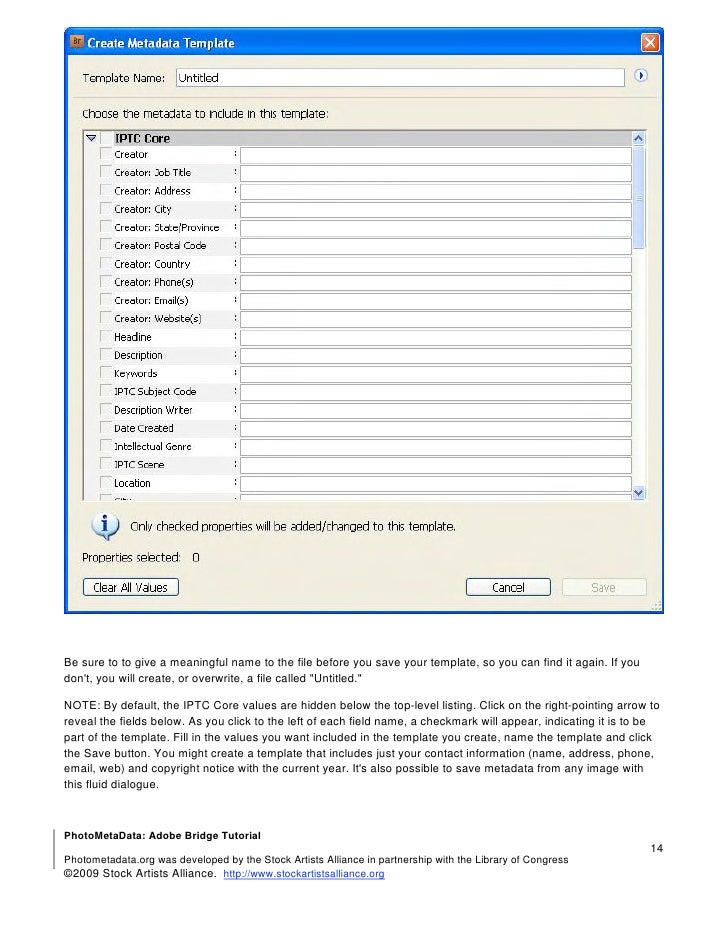

METADATA ADOBE BRIDGE FULL
The last is the full file path, from "C://" to "4100.jpg" which I imported as "Location".Īm I on the right track? Should I be using this script differently? The next attribute is the actual file name - which I imported as "Title". One of the attributes matching the images are "bin numbers" (e.g.: 102.333.201.220) and I thought I could import this as "Keyword 1". I took the column headings out of the CSV. So far so good- until he reminds us that there are image attributes (column headings in an Access table) that we would have to enter by hand. So I demonstrated how we can open the folders of images, display, make collections and keyword, etc. By the time he was finished describing his wish list it sounded like he wanted to re-invent adobe Bridge. I have a huge image database in MS Access. Processing :: C:\Users\8VNWLN1\Desktop\blah-blah-blah\long-list-for-keywords2.csv When I used it I got this error message in a log file: Hi - I like the way this script shows up under it's own Metadata menu. There is the option to remove a header line if one exists.Īn error file is created and shown on completion. Location - Text, if commas are in this field input file MUST be Tab Delimited! Instructions - Text, if commas are in this field input file MUST be Tab Delimited! Title - Text, if commas are in this field input file MUST be Tab Delimited! Headline - Text, if commas are in this field input file MUST be Tab Delimited! These must be last in the list/file!ĭescription - Text, if commas are in this field input file MUST be Tab Delimited! Keywords 2 - These are Keywords in seperate fields. Keywords 1 - These are Keywords that are in ONE field seperated by semicolons

This script will allow you to choose the fields and order they are in within either your CSV or TEXT file so that you can input your metadata. To see an example video of how Adobe Bridge works in action integrated with DAM, visit this demo video we created.************* Requires CS3 or Better **************** It is important to note that unlike Adobe CS6 and previous versions, the panels have to be installed individually for each application.įinal note: If you are implementing a digital asset management platform, DPCI strongly recommends that you integrate the new DAM with custom XMP panels using Adobe Bridge CC.

Type in /Applications/Adobe Bridge CC/Adobe Bridge CC/Contents/Application Data/Custom File Info Panels/4.0/.
METADATA ADOBE BRIDGE HOW TO
The following are instructions on how to install your CS6 Get Info Panels for Adobe Bridge CC: Therefore, you have to do a little trick in order to get it to work. Unfortunately, in order to have the Creative Cloud applications be self-sufficient, they moved the XMP panels to inside of the application. When placing XMP panels in these locations, the Get Info Panel will be accessible to all of your CS6 applications. Windows: /Library/Application Support/Adobe/XMP/Custom File Info Panels/custom.Mac: /Library/Application Support/Adobe/XMP/Custom File Info Panels/custom.Windows: /Library/Application Support/Adobe/XMP/Custom File Info Panels/panels.Mac: /Library/Application Support/Adobe/XMP/Custom File Info Panels/panels.In previous versions of Creative Suite such as CS6, Adobe stored the XMP Metadata Panels and XMP Get Info Panels in the following locations: XMP Get Info Panel


 0 kommentar(er)
0 kommentar(er)
